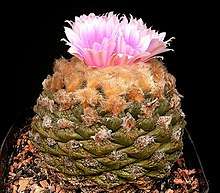Ariocarpus fissuratus
| Ariocarpus fissuratus | |
|---|---|
 | |
| Scientific classification | |
| Kingdom: | Plantae |
| Clade: | Angiosperms |
| Clade: | Eudicots |
| Order: | Caryophyllales |
| Family: | Cactaceae |
| Subfamily: | Cactoideae |
| Genus: | Ariocarpus |
| Species: | A. fissuratus |
| Binomial name | |
| Ariocarpus fissuratus (Engelm.) K.Schum.[1] | |
| Synonyms[1] | |
|
Mammillaria fissurata Engelm. | |
Ariocarpus fissuratus (formerly known as Anhalonium fissuratus) is a species of cactus found in small numbers in northern Mexico and Texas in the United States. Common names include living rock cactus, false peyote, chautle,[1] dry whiskey and star cactus.[2]
Description
This cactus consists of many small tubercles growing from a large tap root. They are usually solitary, rarely giving rise to side shoots from old areoles. The plant is greyish-green in color, sometimes taking on a yellowish tint with age. Its growth rate is extremely slow. A. fissuratus is naturally camouflaged in its habitat, making it difficult to spot.[2] When they are found, it is usually due to their pinkish flowers which bloom in October and early November.[2]
Cultivation
In cultivation, Ariocarpus fissuratus is often grafted to a faster-growing columnar cactus to speed growth, as they would generally take at least a decade to reach maturity on their own. They require very little water and fertilizer, a good amount of light, and a loose sandy soil with good drainage.
Psychoactivity
Ariocarpus fissuratus is a unique species in that it has been used by Native American tribes as a mind-altering substance, usually only as a substitute for peyote.[3] While it does not contain mescaline like many other North American cactus species (such as peyote), it has been found to contain other centrally active substances, such as N-methyltyramine and hordenine,[3] albeit in doses too small to be active.
Notes
- 1 2 3 "Ariocarpus fissuratus". Germplasm Resources Information Network (GRIN). Agricultural Research Service (ARS), United States Department of Agriculture (USDA). Retrieved 2010-10-02.
- 1 2 3 Morey, Roy (2008). Little Big Bend : Common, Uncommon, and Rare Plants of Big Bend National Park. Lubbock: Texas Tech University Press. p. 43. ISBN 9780896726130. OCLC 80359503.
- 1 2 Ratsch, C: "The Sun", page 67. Park Street Press, 2005
References
Ratsch, C. (2005). The Encyclopedia of Psychoactive Plants: Ethnopharmocology and its Applications, Vermont: Park Street Press. ISBN 0-89281-978-2
External links
| Wikispecies has information related to Ariocarpus fissuratus |
| Wikimedia Commons has media related to Ariocarpus fissuratus. |